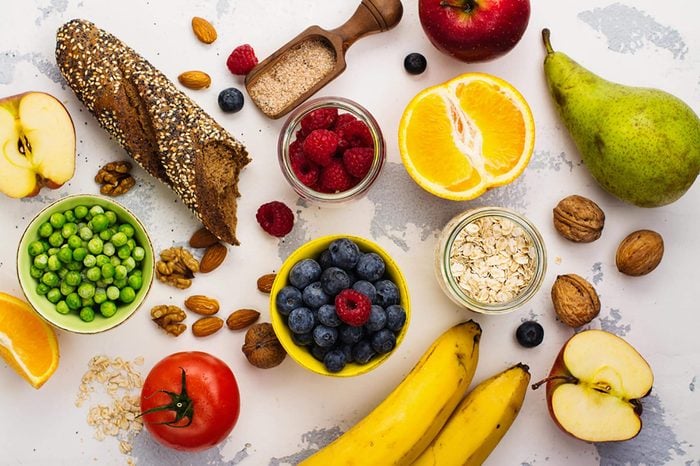
There are two types of fiber
According to U.S. dietary guidelines, adults should consume anywhere between 25 and 30 grams of fiber from food (not supplements) daily. Most of us only get about 15 grams. (Falling short? Here are 30 ways to get more fiber.)
There are two types of fiber, soluble and insoluble. Both play important roles in helping us to maintain healthy digestion and fight off diseases. “Soluble fiber dissolves in water and forms a gel, acting like a sponge in binding cholesterol-rich bile acids, which are then eliminated as waste,” says Melissa Majumdar, RD, senior bariatric dietitian at Brigham and Women’s Center for Metabolic and Bariatric Surgery and Academy of Nutrition and Dietetics spokesperson. This cholesterol-lowering type of fiber is found in oats, peas, beans, apples, citrus, carrots, barley. It’s also found in fiber supplements that use psyllium husk, Majumdar explains.
Insoluble fiber (find it in wheat bran, whole-wheat flour, nuts, beans, potatoes, and vegetables such as cauliflower and green beans), adds bulk to our stool. It also helps move food through the digestive tract. “Insoluble fiber aids in digestion by acting like a broom and cleaning out our intestinal track,” says dietitian Angel Planells, RD, a spokesperson for the Academy of Nutrition and Dietetics. Fiber also provides these other stellar health benefits.
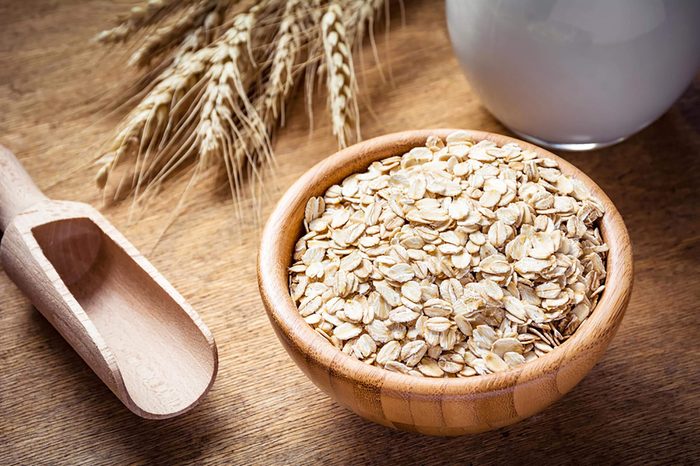
Lower your cholesterol and risk for cardiovascular disease
Add whole-grain dietary fiber as part of a healthy diet and you may improve your blood cholesterol levels, and lower your risk of heart disease, stroke, obesity and type 2 diabetes, according to the American Heart Association. Soluble fiber is what lowers LDL cholesterol—it can also reduce inflammation in the body and lower blood pressure, says Planells. “When soluble fiber enters the small intestine, it acts like a sponge and binds the cholesterol, and doesn’t allow it to be absorbed into the body,” he says. Good sources of soluble fiber include legumes, psyllium, flaxseeds, oats, and oat bran. “Start the day with either steel cut or regular oats—both are a great way to reduce your cholesterol levels.” (Be sure to try this bran muffin recipe this nutritionist swears by.)
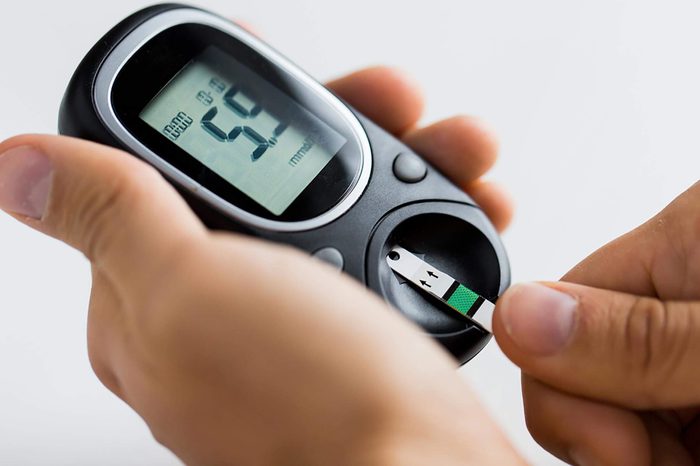
Drop your risk for type 2 diabetes
Eating more fiber is not only good for heart health; research published in Diabetologica in 2015 indicates it can lower your risk for type 2 diabetes. When we add fiber to our diet, our bodies break down carbs more slowly, and this allows our blood sugar levels to rise more gradually, explains Planells. Simple grains or pasta are absorbed rapidly because the sugar is broken down quickly. Instead, choose a whole grain such as quinoa, legumes, oats, or farro, which give you better control over blood sugar. Combine them with one of these 15 superfoods for diabetics for a truly healthy meal.
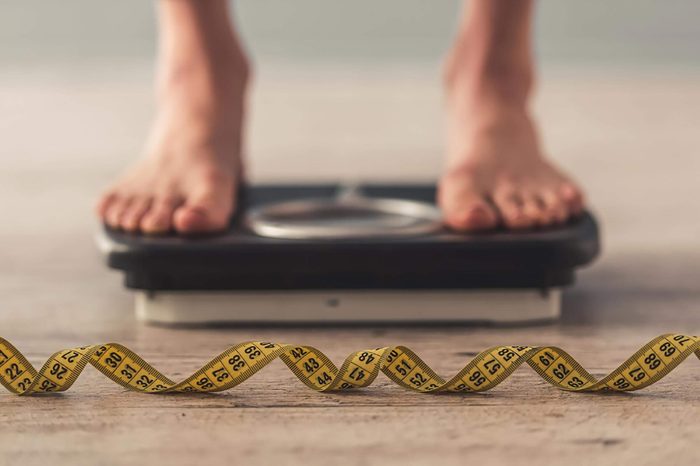
Lose weight and maintain a healthy weight
Reach a healthy weight and stay there and you’ll lower your risk for many conditions. Among them: cardiovascular disease, stroke, type 2 diabetes, and cancer. While losing weight and maintaining the weight loss is not easy, adding fiber to your daily diet can help, according to 2015 research in the Annals of Internal Medicine. “Fiber is linked to having a lower body weight because whole grains are usually lower in calories than high-fat foods,” says Planells. “Fiber calories from high quality, high-fiber foods are also more satiating. They add bulk and slow the digestion process, which makes it more likely for us to lose weight over time.”

Cut your risk for getting kidney stones
Kidney stones hit about one out of every 10 people in the United States. The prevalence of kidney stones has increased from 3.8 percent in the late 1970s to 8.8 percent in the late 2000s, according to the National Kidney Foundation. Drinking up to 12 glasses of water a day, reducing your salt intake, and maintaining a healthy weight can all reduce your risk. Another way to ward off kidney stones? Add more dietary fiber, notes 2018 research published in the International Journal of Molecular Sciences. High-fiber foods such as fruits and vegetables help make your urine less acidic, creating an unfriendly environment for the stones.

Keep your digestive track healthy
Staying regular is key to digestive health and the best way to ensure regularity is to eat more fiber. “Fiber helps food move through the digestive tract. It increases stool bulk, and helps prevent constipation and irregularity,” explains Mujamdar. According to 2017 research published in the journal Nutrients, a high-fiber diet can also help prevent diverticulitis. The painful condition occurs when pouches form in the walls of the colon and become inflamed. “The longer the waste sits in the intestinal track, the longer the body is exposed to toxins. And that increases the risk for disease,” says Planells. “Waste sitting in our gut can promote bad bacteria to develop, which can lead to gastrointestinal problems.” Watch out for these signs that you’re not eating enough fiber.

Boost your energy levels
Fiber may not provide calories (aka energy). But it can help give you a lift by improving your digestion and by slowing down the release of glucose into our bloodstream, explains Majumdar. Fiber slows the sugar dump into the bloodstream, so you won’t have a crazy energy spike after eating. And you won’t bottom out once the carbs are processed, she says. “Refined sugars give you the spike and then you crash.”
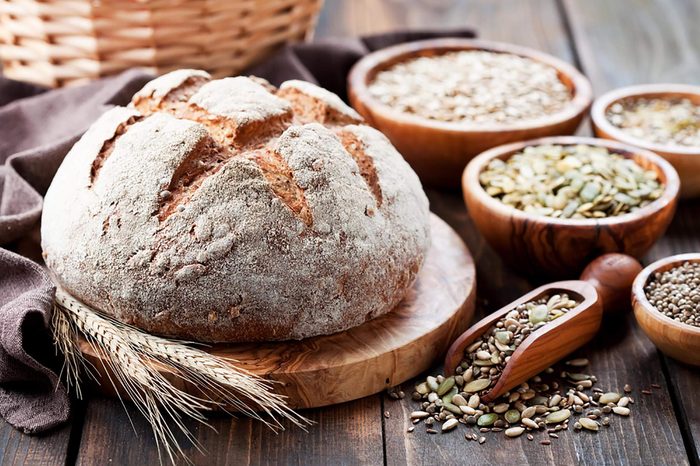
Remember: All things in moderation
Increase your fiber intake gradually, advises Planells. “If you take too much, too quickly, you will go from constipation to diarrhea.” Too much fiber can cause different types of gastrointestinal distress from gas and bloating to constipation to cramping and diarrhea. “If you eat one serving of fruit or vegetable daily, increase it to two, then introduce whole grains.” He also warns that if you have conditions such as diverticulitis, ulcerative colitis, or Crohn’s disease, you may need to eat less fiber. “Err on the side of caution, and check with your physician before you increase your fiber intake.” You may want to check out these diets for people with digestive issues.
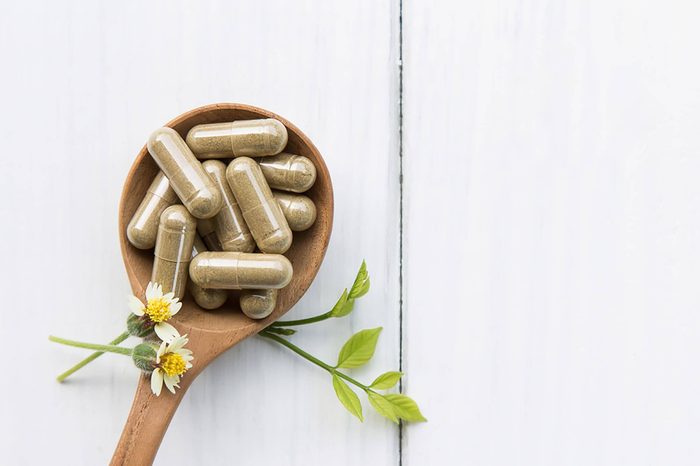
Whole foods are better than supplements
While there is no evidence that taking fiber supplements (made from psyllium husk or methyl cellulose) are harmful, it is better to get fiber from the foods that you eat. They provide vitamins, minerals, and nutrients not found in supplements, explains Majumdar. There are endless ways to add fiber to your daily diet. Start with breakfast. Try a high-fiber cereal or oatmeal and then add shredded carrots, zucchini, or spinach for an added boost. Add nuts, seeds, or beans to your lunch salad. If you make ground meat for dinner, add beans or lentils and some vegetables. It makes the meat go farther and increases the fiber content, she says. When it comes to healthy snacks, Majumdar suggests foods that help you feel fuller longer, such as roasted chickpeas or a piece of fruit. “Any foods that let you eat the peel will have more fiber.”

You may need to drink more water
If you eat more fiber, you may need to drink more water, says Majumdar. Women need around 2.7 liters (91 ounces) of water from food and drink. Men need approximately 3.7 liters (125 ounces daily), according to the National Academies of Science and Engineering. Or simply take your body weight in pounds and divide it by two. That’s the number of ounces you should drink daily, says Majumdar. “If your body is not adapting to the increase in fiber, you may need to drink more water.”
